Vintage Guitars Info's
Vintage Epiphone Guitars.
General Information and Specs.
Epiphone vintage guitars general info and collecting. Private vintage guitar collector. Pictures, history for epiphone vintage guitars.
Contact the Vintage Guitar Info Guy
1965 Epiphone Sheraton (Route 66 Guitars)

- Introduction
- Model Types, Construction, Collectibility
- Model Numbers
- General Specs
- Serial Numbers (How to Find the Year)
- Guitar Model Specs
- Picture Gallery (Epiphone section)
-
Archtop (full depth) Hollowbody Guitar Models
- Emperor, Emperor Regent, Zephyr Emperor Regent archtops
- Deluxe, Deluxe Regent, Zephyr Deluxe, Zephyr Deluxe Regent (and Empire) archtops
- Zephyr, Zephyr Regent archtops
- Broadway (and Bretton) archtop
- Triumph (and Hollywood) archtop
- Tudor archtop
- Devon archtop
- Spartan archtop
- Blackstone archtop
- Century archtop
- Zenith (and Melody) archtop
- Royal archtop
- Beverly archtop
- Olympic archtop
- Byron archtop
- Ritz archtop
- Sheraton electric archtop (semi-hollow)
- Riviera electric archtop (semi-hollow)
- Casino electric archtop (thinline)
- Professional electric archtop (thinline)
- Caiola, Caiola Custom, Caiola Standard electric archtops (thinline)
- Windsor electric archtop (thinline)
- Sorrento electric archtop (thinline)
- Granada, Granada Cutaway electric archtop (thinline)
- FT Deluxe and FT210 Deluxe cutaway flattop
- FT120 Excellente flattop
- FT110 Frontier flattop
- FT79 Texan flattop
Thinline (Gibson-made) Hollowbody Guitar Models:
Flat top Guitar Models:
Solidbody (Gibson-made) Electric Guitar Models:
Introduction:
-
Epiphone was a family business established in 1873 as "the House of
Stathopoulo" by Anastasios
Stathopoulo, a greek violin maker. In 1923 they incorporated and at this
time made mostly high quality and fancy banjos. In 1928 the name was
changed to "Epiphone" after Epi Stathopoulo, president of the company and
one of the founder's sons. In the 1930's, the company changed its emphasis
to guitars. Epiphone was the only banjo company to successfully
switch to guitar production.
Emperor Zephyr Regent.
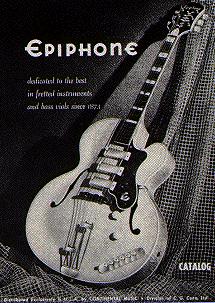
-
In 1952/1953 the C.G. Conn Company's (a band instrument manufacturer)
Orphie got Epiphone distribution rights
moved. Now most guitar production went to Philidelphia (although the labels
still said New York). This was done partially as a "strike break" move,
as New York Epiphone workers were in conflict with the Stathopoulio
family. The Stathopoulo family regained control again in 1955, but
few if any instruments were made in 1956 and 1957.
The Chicago Musical Instrument company (CMI), which owned Gibson, bought Epiphone in 1957. When CMI purchased Epiphone, they got all of Epiphone's current stock of parts including bodies, necks, pickups, etc. Gibson used these "New Yorker" parts in conjuction with their own parts when making Epiphones from 1958 to 1961. By 1961 Gibson has used up all the original New York-made Epiphone parts, and then used Gibson parts made in Kalamazoo. Instruments from 1958 to 1969 are commonly referred to as "Gibson/Epiphones".
-
When Norlin purchased CMI (Gibson) in 1969, all Epiphone production was
moved to Japan. Later, productions was moved to Korea. Many of the imported
instruments bear a label with Gibson's Kalamazoo address and no mention of
Japan or Korea, which can be misleading. However, these import instruments
have model numbers that do not correspond with Kalamazoo made Epiphone model
numbers listed below. Also the serial number is usually 7 digits or longer
(unlike U.S. made Epi's with a 6 digit or less serial number).
Back to the Table of Contents
-
In addition to the Zephyr and Zephyr Regent models, Epiphone applied the
two terms to other models to signify electric or cutaway:
- Zephyr = electric.
- Regent = cutaway.
Contruction and Value.
-
High-end acoustic archtop Epiphones are constructed of high quality, solid
woods. Electric archtop Epiphones are made from laminated woods. Because
of this, electric archtop Epiphones are much less desirable, and are worth
considerably less than fully acoustic archtop models.
Pre-1937 Epiphones are of very high quality and are generally much scarcer than later models. They have a smaller body and less modern neck feel than later models, and are less collectable.
The most collectable models are those made from 1937 when body sizes were increased, up to the end of New York productions (1956). Most desirable are the professional grade models on which the company built its reputation: Emperor, DeLuxe, Broadway and Triumph. These models, along with Gibsons, are considered by most to be the best vintage factory-made archtop guitars produced. Mid-range and low-end models are generally regarded as student model instruments.
Electric Archtop Epiphones.
-
New York-made electric archtops are interesting but generally are not
as collectable as equivalent acoustic models. Acoustic models are
solid carved top and back whereas electrics are plywood. In addition,
the electronics on New York Epiphones are not as sonically good as
compared to Gibson of the same period or to the later Gibson-made
Epiphones. Therefore, New York electric archtop Epiphones are worth
considerably less than Gibsons of the same period.
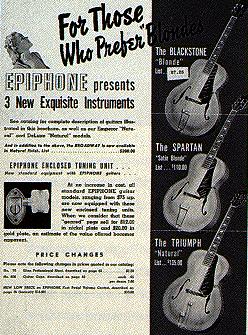
Early Gibson Epiphones with New York pickups are of interest to collectors. Most hollowbody Epiphone electrics bring less than the equivalent Gibson models. Double cutaway thinbody electrics are the most highly sought after electric archtop models. The Emperor (single cutaway) is the rarest of the thinlines (66 made). The Sheraton, especially the early version with blond finish, is also very collectable. Sheratons with New York pickups are worth the most, but not for sound. The Riviera, though equal in playability and sound, is not nearly as collectable. The Casino is collectable only because John Lennon played one.
It may seem like a contridiction in terms: New York pickups are sonically inferior to Gibson pickups, but models fitted with New York pickups from 1958 to 1960 are worth more than post-1960 models fitted with better Gibson pickups. These Epiphone models made from 1958 to 1960 like the Sheraton and Coronet are much more collectable (and valuable) with New York pickups, even though everyone agrees the later models sound much better fitted with Gibson pickups.
-
Solidbody electric Epiphones with New York pickups are interesting to
collectors, but not for their sound. Later solidbody models with mini-
humbucking pickups bring less money than Gibson equivalents with
standard humbucking pickups. None are especially valuable, although
Epiphone workmanship and playability is equivalent to Gibson of the same
period.
Back to the Table of Contents
Epiphone Model Numbers, 1953 to 1981
-
Model numbers date from Epiphone's ownership by Conn in 1953 until Gibson
moved Epiphone production to Japan in 1970.
Letters preceding model number: E=electric archtop, A=acoustic archtop, FT=flattop, SB=solidbody, EB=electric bass or banjo, EC=classical, EM=mandolin, BV=bass violin.
Letters after model number: D=double cutaway, N=natural finish, T=thinbody, V=vibrato, MV=maestro vibrola, C=cherry or cutaway, E=electric.
1953 to 1970 Model Numbers
Number Prefix Model ------ ------ ----- 7P EA Professional 8P EA Professional 28 FT Caballero tenor 30 EC Madrid 30 FT Caballero 44 EB Campus banjo 45 FT Cortez 66 EM Venetian mandolin 77 ETB Tenor banjo 79 FT Texan 85 FT Serenader 88 EB Minstrel banjo 90 EC Entrada 90 FT El Dorado 95 FT Folkster 98 FT Troubadour 100 EC Seville 110 FT Frontier 111,112 E Emperor (blond, sunburst)* 111,112 A Emperor cutaway (blond, sunburst)* 112 FT Bard 120 FT Excellente 121,122 A Emperor non-cutaway (blond, sunburst)* 150 EC Classic 188 EB Plantation banjo 200 EC Espana 210 FT Deluxe Cutaway 211,212 E Deluxe, 1949 to 1956 (blond, sunburst)* 211,212 E Sheraton, 1958 to 1970 (blond, sunburst)* 211,212 A Deluxe cutaway (blond, sunburst)* 221,222 A Deluxe non-cutaway (blond, sunburst)* 230 E Casino 231,232 EB Rivoli (blond, sunburst)* 232 SB Crestwood Deluxe 251,252 E Broadway (blond, sunburst)* 300 EC Barcelona 311,312 E Zephyr thinline cutaway electric (blond,sunburst)* 311,312 A Broadway cutaway (blond, sunburst)* 321,322 E Zephyr non-cutaway (blond, sunburst)* 321,322 A Broadway non-cutaway (blond, sunburst)* 332 SB Crestwood 351,352 E Windsor (blond, sunburst)* 360 E Riviera 411,412 A Triumph cutaway (blond, sunburst)* 421,422 A Triumph non-cutaway (blond, sunburst)* 421,422 E Century (blond, sunburst)* 432 SB Wilshire 444 E Granada 451,452 E Sorrento (blond, sunburst)* 521,522 A Devon (blond, sunburst)* 533 SB Coronet 621,622 A Zenith (blond, sunburst)* 721 SB Olympic Special 722 SB Olympic Caiola Caiola EBDL Embassy Deluxe EBS Newport EBV Rivoli Hr-SE Howard Roberts Standard HR-CE Howard Roberts Custom ------ ------ ----- Number Prefix Model* In 1961, Gibson began using only the even-number model designation for sunburst, blond or any other finish.
1971 to 1981 Japanese Model Numbers
Note: not interested in these model. Information here for completeness.
Model number listed on a blue label with a Kalamazoo address, but usually
say "Made in Japan" at the bottom edge of the label.
Number Prefix Model ------ ------ ----- 20 EC Mahogany Classical 22 EC Mahogany Classical 23 EC Mahogany Classical 24 EC Rosewood Classical 25 EC Rosewood Classical 120 FT Dreadnoght Flattop (introduced 1979) 130 FT Mahogany Dreadnought Flattop 132 FT Mahogany Dreadnought Flattop 134 FT Mahogany Dreadnought Flattop 135 FT Rosewood 000 size Flattop 140 FT Dreadnought Flattop (introduced 1979) 145 FT Mahogany Jumbo Flattop 147 FT Mahogany Jumbo Flattop 150 FT Rosewood Jumbo Flattop 155 FT Ash Jumbo Flattop 160 FT 12 string Mahogany Flattop 165 FT 12 string Rosewood Flattop 250 EA Electric Acoustic, double cutaway, 2 PUs 270 ET Solidbody Electric 275 ET Solidbody Electric 278 ET Solidbody Electric
Back to the Table of Contents
Left: Epiphone label as used from 1935 to 1956; this one is 1956.
Right: Epiphone label as used on Gibson-made guitars from 1958 to 1969; this
one is 1960
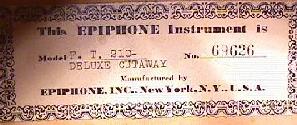
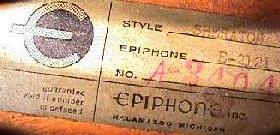
-
General Specs:
- "Epiphone Banjo Corporations, Long Island City, NY": 1928-1935.
- Masterbilt label, high-end models, several different label styles, all with
- "Masterbilt" in fancy lettering: 1931-1937.
- Silver oval label, "The Epiphone Corp" on banner, "New York" and "Builders of Art Musical Instruments" below banner: 1932-1933.
- Rectangular label, white paper with blue or blue-green border and "Epiphone, Inc, New York, NY, USA": 1935-1956.
- Gibson made, rectangular label, blue paper, slashed C logo and "Epiphone Inc, Kalamazoo, Michigan": 1958-1970.
- Row 1: 1941 TrueBalance Zephyr pickup, 1947 Zephyr Master pickup
- Row 2: 1948 Tone Spectrum Zephyr Deluxe pickup, 1950 non-adjustable NewYork Century pickup.
- Row 3: 1950's Adjustable DeArmond pickups, 1949 Tone Spectrum pickups, 1949-1961 "NewYork" pickups.
- New York: retangular metal covered with small slot-screw poles, poles very close to edge, mounted to top by screws through cream-colored "blocks" or side extensions, dimensions 1 1/8" by 2 13/16" (3 5/8" wide including mounting blocks): 1946-1961.
- Rectangular metal covered, larger than New York style, 1 1/2" by 3 1/8", phillips-head screw poles, poles not in center but not as close to edge as New York style, yellow/cream colored frames: 1950-1954.
- Gibson made Mini-Humbucking: used on Gibson modela like the 1969 Les Paul Deluxe, samller than Gibson standard humbucking pickup, 1 1/8" by 2 5/8", double coil, rectangular metal covered, slot head screw poles close to edge, black plastic frame, similar in size to the New York style pickup: 1961 to 1969.
- Gibson made P-90 pickup: standard on many Gibson models of the period,
single coil, poles across center, attached by screws through triangular
"ears" extending from each end, some models fitted with rectangular
(no ears) "soapbar" P-90 pickup covers.
- Frequensator: allows for a longer string length on the 3 bass strings, shorter string length on the 3 treble strings, sometimes reversed by players to accommodate short strings, high end models: 1939-1970.
- Vibrato: flat-arm, strings wrap around metal cylinder of graduated diameter, wooden plate with E logo: 1961-1970.
- No truss rod: pre-1939.
- Truss rod adjustment at body end of neck: 1939-1951.
- Truss rod adjustment at peghead: 1951 and later.
- Script: most Epiphones of the pre-Gibson period have a script logo with a standard script "E". A few early models have block letter logos. Gibson continued using New York-made Epiphone necks, with laminated construction and script "E" logo, until all New York necks were used.
- Slashed "C": Epiphone's stylized "E", which looks like a "C" with a horizontal slash, appeared in 1939 in literature and on metal peghead plates.
- Models with inlaid or paint logos made the changeover to Gibson necks and the slashed "C" logo style circa 1961. On flat tops, the Gibson neck can be distinguished by a wider flare towards the top of the peghead. By the 1963 catalog, all solidbody guitars are pictured with the slashed "C" logo.
-
Labels:
Different Epiphone Pickups used.
Pic thanks to LB Fred.
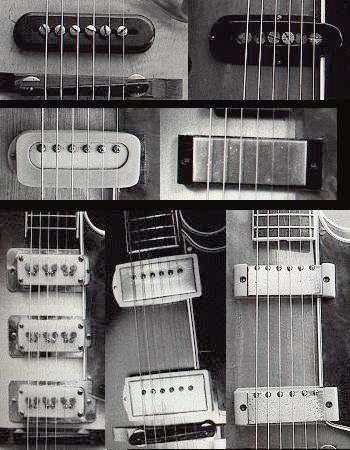
Epiphone New York era pickups (left to right):
Note: "New York" style pickups (right side column 3 above, and color picture below) are the most
common New York-era Epiphone pickup. They are also considered the "best" top-of-the-line
pickup model for pre-1962 Epiphones.
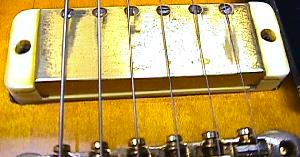
-
Pickups:
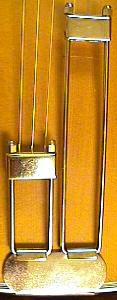
-
Tailpieces:
Truss Rod:
-
Tuners:
Epiphone used their own tuners with a slashed "C" logo and a pearloid button from about 1947 to 1961 on most mid to high-end models. On their low-end guitars, they used an assortment of different tuners.
Epiphone style tuners as used on most
mid to high-end guitars.
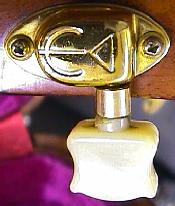
-
Logos:
Peghead "ferns". These varied considerably from guitar to
guitar, year to year.
Left: peghead style on most Deluxe models. Note the standard script "E"
and cloud style fingerboard inlay. On some Deluxe model, Epiphone
used Emperior style fingerboard inlays instead.
Middle: peghead style on most high-end models like the Emperior.
Note the standard script "E" and "V" fingerboard inlay; it's pearl with a "V" insert
of abalone.
Right: close-up of the "V" inlay used after WW2 on Emperor models
and certain Deluxe models. Before the war,
the "V" inlays were all pearl (no abalone), and had a black separating
line to separate the "V" from the block.
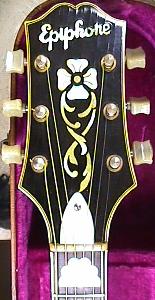
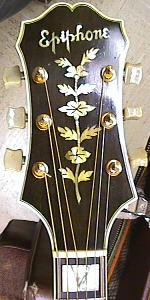
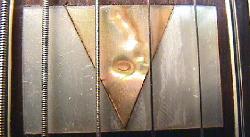
-
Necks:
After Gibson bought Epiphone in 1957, Epiphone parts were used up before Gibson parts were issued. This occured on Gibson-made Epiphone starting in 1958. In addition to New York pickups, both acoustics and electrics featured New York necks with a pronouced "V" shape that Gibson necks did not have. The New York Epiphone peghead shape is also different from that of the later Gibson made necks. The stock of Epi-made necks ran out in late 1961 or early 1962 on most models.
Binding on an Epi: very typical to see shrinking binding
pulling away from the body on NY era Epi's.
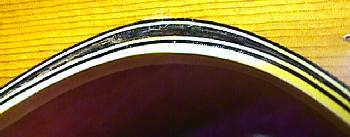
-
Binding:
The binding used on NY era Epiphones (1958 and before) was troublesome.
The binding was made of celluloid, and glued in place with an Acetone
based glue. The problem is that the binding shrinks considerably with
age, and can literial turn to dust. There is no way to fix this short
of replacing the binding. Environmental issue (UV light and temperature
extremes) can make the problem worse.
These were used from the late 1940's
until about 1960. The brass "ten position"
nail was Gibson's idea to embelish these
knobs.
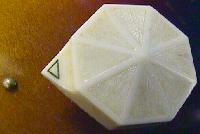
-
Knobs:
Epiphone most typical electric guitar knob of the 1950's was the
"carrosel" knob. This bakelite material knob was very unique
to epiphone.
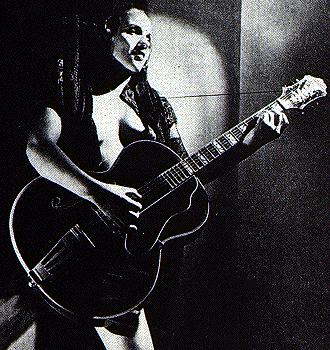
PegHead Markings other than Serial Numbers ("seconds")
-
When Gibson owned Epiphone (after 1957), they often marked inferior quality
guitars as "seconds", and sold
them at a discount to dealers or employees. These markings were stamped
into the wood on the back of the peghead. A "2" stamp is sometimes seen,
designating a "second", which had some cosmetic flaw. If there is a serial
number on the back of the peghead, the "2" is usually seen centered above
or below it. Another type of Gibson/Epiphone reject stamp is the "BGN"
stamp, designating that instrument as a "bargin" guitar. These were only
sold to employees at substantial discounts. This stamp is also seen on the
back of the peghead. Sometimes the "BGN" is stamped vertically with
the "N" below the "G" which is below the "B". BGN instruments weren't
acceptable to Gibson/Epiphone as sellable to the public.
-
All second instruments are usually worth less than the same guitar that is
not a second (given condition as the same). BGN instruments are worth less
than a second instrument because these tend to have some fairly serious
cosmetic flaw.
Back to the Table of Contents
December 1947 Epiphone ad.
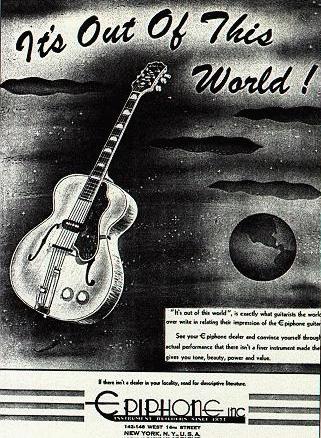 Epiphone Serial Numbers (How to Find the Year).
Epiphone Serial Numbers (How to Find the Year).
-
The easiest way to tell the year of an Epiphone instrument is by
its serial number.
Serial numbers are from Jim Fisch, L.B. Fred, Tom Wheeler, Walter Carter.
There are no known factory ledgers for Epiphone. Therefore all serial numbers/years are approximations. Many serial numbers/years have been drawn from the sales records of Petty Music Company of Pittsburgh. Because this in the only known serial number/year sold list, it is the only real data available. Obviously it has some shortcomings as it is just the sales for one music store.
For the most part serial numbers after 1932 are consecutive, and hence provide production numbers indicating the number of instruments produced.
-
Jim Fisch, L.B. Fred have established an Epiphone serial number registry. This
has helped in the dating of old Epiphones, and has given a lot of
information regarding production numbers. Obviously any production
number conclusions drawn are based on the instruments Jim has
recorded only.
-
Serial Numbers, 1932 to 1944, acoustic guitars only.
For 1932 and 1933, the serial number is die-stamped on the interior side of an instrument's back. You can see this by looking thru the bass-side "f" hole, generally below the applied label. From 1934 forward, the serial numbers were typed or stamped directly on the Epiphone label. The last documented serial number in this series is 20142.
Year Number Range ---- ------------ 1932 5000 to 5999 1933 6000 to 7199 1934 7200 to 7999 1935 8000 to 9999 1936 10000 to 10999 1937 11000 to 11999 1938 12000 to 12999 1939 13000 to 14499 1940 14500 to 15999 1941 16000 to 17499 1942 17500 to 18199 1943 18200 to 18999 1944 19000 to 20999
-
Serial Numbers, 1935 to 1944, electric instruments only.
With the start of the Electar model line in late 1935, Epiphone began a new serial number system for their electric instruments only. These numbers are die-stamped and are between 3 and 5 digits in length. Usually they are located on the top rear of the peghead. Since these numbers were applied before the instrument was painted, the serial number only gives an approximate age (especially on less popular instruments such as electric banjos and electric mandolins).
Year Number Range ---- ------------ 1935 001 to 249 1936 250 to 749 1937 750 to 1499 1938 1500 to 2499 1939 2500 to 3499 1940 3500 to 4999 1941 5000 to 6499 1942 6500 to 7499 1943 7500 to 8299 1944 8300 to 9999
Serial Numbers, 1944 to 1950, acoustic guitars only.
For some reason, a new numbering system was started in 1944. The
starting point of serial number 50,000 was used.
There were a couple of reasons for this:
the death of Epi meant his widow's shares where purchased causing
a financial restructuring of the company and it's assets. Also
changes in production methods prompted a change in inventory
and the numbering scheme.
Year First Number ---- ------------ 1944 50,000 to 51,999 1945 52,000 to 53,999 1946 54,000 to 55,999 1947 56,000 to 56,999 1948 57,000 to 57,999 1949 58,000 to 58,999 1950 59,000 to 59,999
Serial Numbers, 1944 to 1950, electric guitars only.
From 1944 to the end of 1950, specific 2-digit prefixes were assigned
to individual electric models. The ending 3 digits indicated the
actual production number. Unfortuneatly, there is no data available
for exact production numbers/years at this time.
This impressed serial number may be found
on the back top of the peghead.
Model# Production# Model Name ------ ----------- ---------- 15 000 Century Hawaiian, other Hawaiians 25 000 Zephyr Spanish 26 000 Zephyr Spanish 60 000 Century Spanish 75 000 Zephyr DeLuxe 85 000 Zephyr DeLuxe Regent
Serial number on a 1956 Epiphone acoustic guitar.

-
Serial Numbers, 1951 to 1956, acoustic and electric guitars.
The last known New York-made Epiphone was serial number 69637 (Epi Zephyr).
Year Number Range ---- ------------ 1951 60000 to 63999 1952 64000 to 64999 1953 64000 to 66999 1954 67000 to 67999 1955 68000 to 68999 1956 69000 to 69999
"Ink stamped" serial number on a
1959 model solidbody.
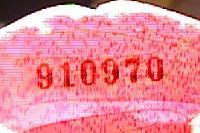
-
Gibson-made Serial Number, 1958-1960, solidbody guitars.
Number is ink stamped on the back of the peghead. As with Gibson solidbody guitars of the same period, the first digit of the serial number is the last digit of the year.
Year 1st Number ---- ---------- 1958 8 1959 9 1960 0
Gibson-made hollowbody serial number as used from 1958 to 1961.

-
Gibson-made Serial Numbers, 1958 to 1961, hollowbody guitars
("A" series).
Hollowbody models: number is on the label, with "A" preceding the number. The Epiphone number series is different than the A-series used on Gibson brand instruments of the same period.
Year Number Range ---- ------------ 1958 A1000 to A1999 1959 A2000 to A2999 1960 A3000 to A3999 1961 A4000 to A4999
Serial number as used from 1961 to 1969.
This is a 1962 Epiphone Coronet.
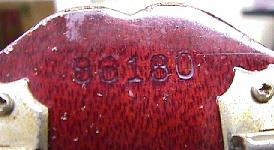
-
Gibson-made Serial Number, 1961 to 1969, all instruments
(non "A" series).
Beginning in 1961, Epiphone serial numbers follow Gibson's serial number series. All models, stamped in back top of peghead. No "MADE IN USA" stamp below serial number! Note many serial numbers are duplicated from 1963-1969. To figure out which is the exact year for a guitar, see the General Specs section for details. Numbers thanks to Walter Carter.
Number Range Year ------------ ---- 0100 to 42440 1961 42441 to 61180 1962 61450 to 64222 1963 64240 to 71040 1964 71041 to 96600 1962, a few from 1963/1964 96601 to 99999 1963 000001 to 099999 1967 (all 6 digit numbers starting with "0" are 1967) 100000 to 106099 1963 or 1967 106100 to 106899 1963 109000 to 109999 1963 or 1967 110000 to 111549 1963 111550 to 115799 1963 or 1967 115800 to 118299 1963 118300 to 120999 1963 or 1967 121000 to 139999 1963 140000 to 140100 1963 or 1967 140101 to 144304 1963 144305 to 144380 1964 144381 to 149864 1963 149865 to 149891 1964 149892 to 152989 1963 152990 to 174222 1964 174223 to 176643 1964 or 1965 176644 to 250335 1964 250336 to 305983 1965 306000 to 310999 1965 or 1967 311000 to 320149 1965 320150 to 320699 1967 320700 to 329179 1965 329180 to 330199 1965 or 1967 330200 to 332240 1965, 1967 or 1968 332241 to 348092 1965 348093 to 349100 1966 349121 to 368638 1965 368640 to 369890 1966 370000 to 370999 1967 380000 to 385309 1966 390000 to 390998 1967 400001 to 406666 1966 406667 to 409670 1966 to 1968 409671 to 410900 1966 410901 to 419999 unknown 420000 to 429193 1966 500000 to 500999 1965, 1966, 1968, or 1969 501009 to 501600 1965 501601 to 501702 1968 501703 to 502706 1965 or 1968 503010 to 503109 1968 503405 to 520955 1965 or 1968 520956 to 530056 1968 530061 to 530850 1966, 1968, or 1969 530851 to 530993 1968 or 1969 530994 to 539999 1969 540000 to 540795 1966 or 1969 540796 to 545009 1969 555000 to 556909 1966 558012 to 567400 1969 570087 to 570643 1966 570645 to 570755 1966 or 1967 570857 to 570964 1966 580000 to 580080 1969 580086 to 580999 1966, 1967 or 1969 600000 to 600998 low end models, 1966, 1967, or 1968 600000 to 606090 high end models, 1969 700000 to 700799 1966, 1967 or 1969 750000 to 750999 1968 or 1969 800000 to 800999 1966, 1967, 1968 or 1969 801000 to 812838 1966 or 1969 812900 to 819999 1969 820000 to 820087 1966 or 1969 820088 to 823830 1966 824000 to 824999 1969 828002 to 847488 1966 or 1969 847499 to 858999 1966 or 1969 859001 to 895038 1967 895039 to 896999 1968 897000 to 898999 1967 or 1969 899000 to 899999 1968 900000 to 901999 1970 910000 to 999999 1968 ------------ ---- Number Range Year
to Epiphone Model Info
Back to the Table of Contents
Copyright 1995-2002 all rights reserved.